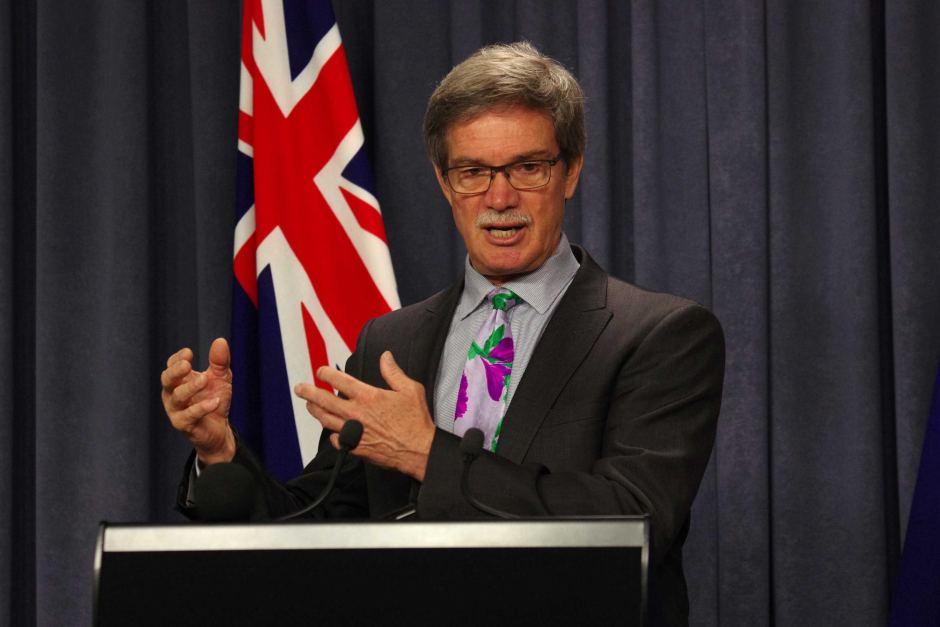Category: Business, Economics and Finance / Government and Politics
Why should you care about WA's mid-year economic review
Thursday, 22 Dec 2016 14:42:26 | Jacob Kagi

Dr Nahan's tie could be the main thing many voters focused on today. (ABC News: Andrew O'Connor)
As WA Treasurer Mike Nahan walked in to deliver his final economic update ahead of next year's state election, he joked his festive tie was designed to distract attention from the dire numbers in the mid-year review.
Dr Nahan's flashy neckwear may be what voters take away from the announcement, since information about Government finances is a sure-fire path to boredom for many.
But with a poll to be held within months, and WA's finances in a precarious position, there is good reason for voters to care about much more than the Treasurer's fashion sense.
So what is the mid-year review and what's in it?
 Photo:
Dr Nahan says simply cutting expenditure will not get WA's debt under control. (Alan Porritt: AAP)
Photo:
Dr Nahan says simply cutting expenditure will not get WA's debt under control. (Alan Porritt: AAP)
As the name suggests, it is an update of forecasts of revenue and expenditure which were made in the 2016-17 budget in May.
While the deficit for this year is now set to be $526 million less than previously feared, the state will still be a record $3.39 billion in the red.
Treasury projects debt will continue to rise — reaching nearly $40 billion by mid 2019. Deficits are expected to continue until 2019-20.
What does it mean for me?
There are no new taxes, nor are there any increases to fees or charges. But a growing debt bill is inevitably going to put upward pressure on taxes and also force current and future governments to look at services and other spending.
Dr Nahan used his mid-year review speech to claim debt could not be reduced to an acceptable level by simply reducing expenditure and, if that is the case, the state faces big decisions about its financial future which will affect all West Australians.
Meanwhile, if treasury's forecasts are to be believed, WA's unemployment rate will remain at 6 per cent or higher until 2020.
What's changed since the budget?
 Photo:
Iron ore prices have been better than expected, boosting the budget's bottom line. (Supplied by BHP Billiton)
Photo:
Iron ore prices have been better than expected, boosting the budget's bottom line. (Supplied by BHP Billiton)
The better-than-expected iron ore price has had a positive impact on the budget, with royalty forecasts $3.7 billion better over the next four years than they were in the May budget.
But projected taxation revenue has taken a $1.9 billion hit for the same period.
Hopes of a recovery in the state's GST share have been significantly wound back, costing the state $1.6 billion between now and mid 2020.
There are also new expenses to fund, with $316 million in new health costs leading the way and a $77 million price tag caused by the delayed opening of the new Perth Children's Hospital.
What does all this mean for the election?
 Photo:
The economic debate will heat up ahead of the state election in March. (ABC News: Andrew O'Connor)
Photo:
The economic debate will heat up ahead of the state election in March. (ABC News: Andrew O'Connor)
The poor state of WA's finances poses problems for both major parties.
The Government needs to attempt to show itself to be the state's best economic manager which is likely to be a difficult task given its reign has featured record debt and deficit figures.
But Labor will also face questions about how it plans to pay down debt and fund its expensive promises, such as its proposed Metronet rail system.
The dire financial situation has already prompted debate about measures to increase revenue — with the Liberals proposing to sell Western Power and the Nationals advocating a new mining tax on BHP and Rio Tinto.
That debate will continue to heat up as the election draws nearer.
- About Us
- |
- Terms of Use
- |
-
 RSS
RSS - |
- Privacy Policy
- |
- Contact Us
- |
- Shanghai Call Center: 962288
- |
- Tip-off hotline: 52920043
- 沪ICP证:沪ICP备05050403号-1
- |
- 互联网新闻信息服务许可证:31120180004
- |
- 网络视听许可证:0909346
- |
- 广播电视节目制作许可证:沪字第354号
- |
- 增值电信业务经营许可证:沪B2-20120012
Copyright © 1999- Shanghai Daily. All rights reserved.Preferably viewed with Internet Explorer 8 or newer browsers.




 Send to Kindle
Send to Kindle